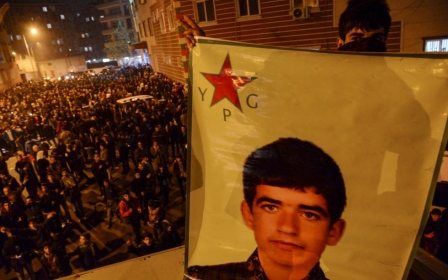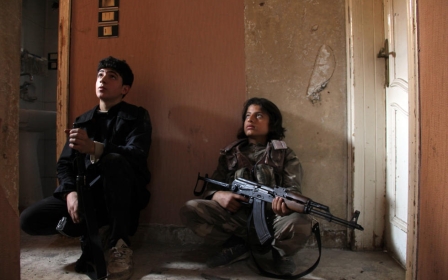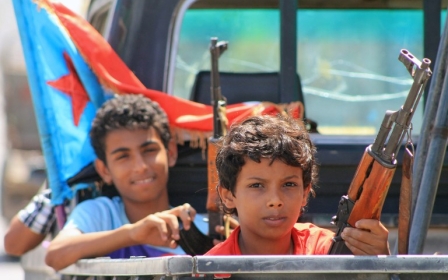Casualty of war: Child soldiers in Yemen

SANAA - "I wish that I had received my child dead, not just injured," said Um Sultan, whose 15-year-old son was injured in the battle of Taiz between the Houthis and the Southern Popular Resistance in August.
Sultan Abdulwali joined the Houthis in June 2015. Although his entire family - especially his mother - was not happy with his support for the Houthis, they could not prevent him from joining their forces. Having mixed feelings about her son's decision, Um Sultan told Middle East Eye: "I know that my son is a Houthi supporter and I tried so hard to stop him from joining their ranks, but I failed with every attempt because he was so influenced by his friends, and many of the kids in the neighbourhood are Houthi fighters."
By the end of July Sultan had joined the Houthi rebels without the knowledge of his family. They soon left Sanaa for Taiz. Shortly after, the Popular Resistance targeted Abdulwali's military vehicle. Eight fighters were killed and two were wounded, including Abdulwali.
Wounded, Sultan was returned back to his mother in Sanaa. "Sultan is my only son. While I have four daughters, I loved him more than his sisters. Every day I pray that Allah will take him, because even though he is still injured and I pay so much for his treatment, he disobeys me and still supports the Houthis," Um Sultan said.
Um Sultan says she suspects that the Houthis used magic to attract her only son, stating that none of her family members could persuade her son to leave their ranks and return to school.
New MEE newsletter: Jerusalem Dispatch
Sign up to get the latest insights and analysis on Israel-Palestine, alongside Turkey Unpacked and other MEE newsletters
Sultan's father is working in Saudi Arabia, so he cannot help the family and be there to influence his son. "I am now in my 40s and I cannot control my son. Many times he has tried to hit me if I attempt to prevent him from doing something wrong, but his sisters stop him when he tries to harm me."
Like other Houthi fighters, Sultan was given a rifle for the battlefield. But according to Um Sultan, child soldiers use the rifles to threaten their friends and families as well.
According to UNICEF, children with the Houthis and other armed groups comprise up to one-third of all fighters in Yemen.
Child soldiers insist on fighting
Sultan became disabled and cannot walk due to a severe leg injury during the attack in Taiz. An additional shell fragment also hit him in the back.
"If I recover soon I will join the battle in Taiz again to fight againt al-Qaida in the Arabian Peninsula [AQAP] and Islamic State [IS] fighters in Taiz," Sultan told MEE
All that Sultan knows is that the Houthis are fighting AQAP and IS fighters in Taiz - the details of Yemen's complex political situation are over his head.
In November 2012, the head of the Houthis, Abdulmalik Badr al-Deen al-Houthi, pledged to work toward stopping the use of child soldiers.
Naif Nor Addin, a sociologist based in Taiz, told MEE that it is not only the Houthis who recruit children, but all warring sides, because it is easy to pursuade children to fight.
"Children, especially between the ages of 13 and 16, like to do new things, often for attention. Fighters often take advantage of this by giving rifles to the children at this age."
Nor Addin also said that this age is a time when children are often swayed more by the words of their peers than by their parents. One boy can often persuade several others to join up, especially if their parents are unaware of what is going on.
Inside the capital city, several children stand at Houthi checkpoints. Many are also seen in Houthi military vehicles.
'I hope parents watch their sons carefully'
The way 55-year-old Ahmed Murshed sees it, if a boy is older than 13, he is not a child. Rather, he is a man who knows very well what he is doing.
Murshed is originally from the Raimah province, but he works in Sanaa as a guard. He is illiterate and says that this is why he allowed his 16-year-old son Fahd to drop out of school three years ago.
Fahd Murshed used to work in construction in Sanaa, but when the Houthis started recruiting last March, he was happy to join their ranks, even if his father was not happy with his decision.
"Without my knowledge, Fahd left Sana'a towards Taiz in the beginning of August. When I phoned him to ask where he was, he told me that he was at work in Hajja province. I believed him because I thought he was a man." Murshed told MEE.
Murshed did not follow the whereabouts of his son. He was under the impression that he had gone to Hajja to collect money in order to could buy a motorcycle, something that for he had spoken of for long. But in truth he had joined the Houthis.
"On 12 August, a Houthi car came to my house and two Houthis started to talk with me about the blessing of being a martyr," Murshed told MEE. "Then I understood that something bad had happened to my son. I asked them, 'Where is Fahd?'h They said, 'He is with his God in Paradise.'"
"Then they showed me the dead body of my son, asking me to take him home, but I refused to receive it, not because I hate my son, but to let them know that they stole my son without my knowledge and also to let them know that people do not support the recruiting of children."
He told MEE that it was after Fahd had been killed that he came to understand that he was still just a child, that he wasn't a man, and didn't understand what he was doing.
"I hope that all parents watch their sons very carefully and refuse to let them go anywhere without their knowledge. I regret that I did not watch my son more carefully.”
Amal Mamoon contributed to this article.
Middle East Eye delivers independent and unrivalled coverage and analysis of the Middle East, North Africa and beyond. To learn more about republishing this content and the associated fees, please fill out this form. More about MEE can be found here.




